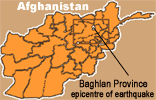UN brings aid to quake-stricken parts of Afghanistan; Karzai visits epicentre
 |
Mr. Karzai, who was accompanied on his visit to the epicentre by Secretary-General Kofi Annan’s Deputy Special Representative Nigel Fisher, studied the area amid continuing aftershocks, according to a UN spokesman. The delegation identified three priority areas for relief efforts, including a total of 25 villages in the Panjshir Valley, Lakankhel and Burkha.
With UN agencies reporting cautious optimism about their ability to meet immediate needs, the World Food Programme (WFP) has deployed some 552 metric tons of food aid to the area – enough for the next three months. In addition, UN and other relief agencies have delivered some 15,000 tents and 100,000 blankets. The World Health Organization (WHO), which sent in today an emergency medical team and supplies, said it would support Afghan officials in coordinating health relief efforts.
Meanwhile, a senior UN humanitarian official in New York said today that there were 600 confirmed deaths, but the toll was expected to rise. “We estimate now that the total number of confirmed dead will tally between 800 and 1,200,” Kevin Kennedy, Chief of the Humanitarian Emergency Branch in the UN Office for the Coordination of Humanitarian Affairs, told a press briefing at UN Headquarters.
Mr. Kennedy stressed that roughly 20,000 families – or up to 100,000 people – had been affected by the devastation. A helicopter assessment of Nahrin found that some 90 per cent of all houses had been damaged.
“This area did not begin suffering two days ago,” Mr. Kennedy observed. “It is one of the more remote areas of Afghanistan – it is in the heart of the drought belt and has suffered food problems for the last four years.”
The relief efforts are being further complicated by aftershocks, as well as “the already existing landmine threat,” he pointed out, noting that Nahrin had been heavily mined during fighting between the Taliban and the Northern Alliance. The UN, he added, had deployed a number of deminers to the area to help clear the roads.
